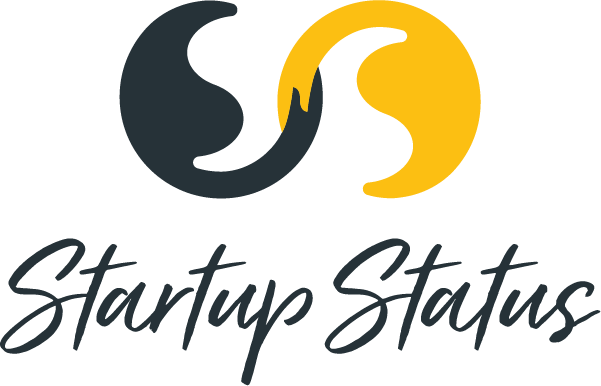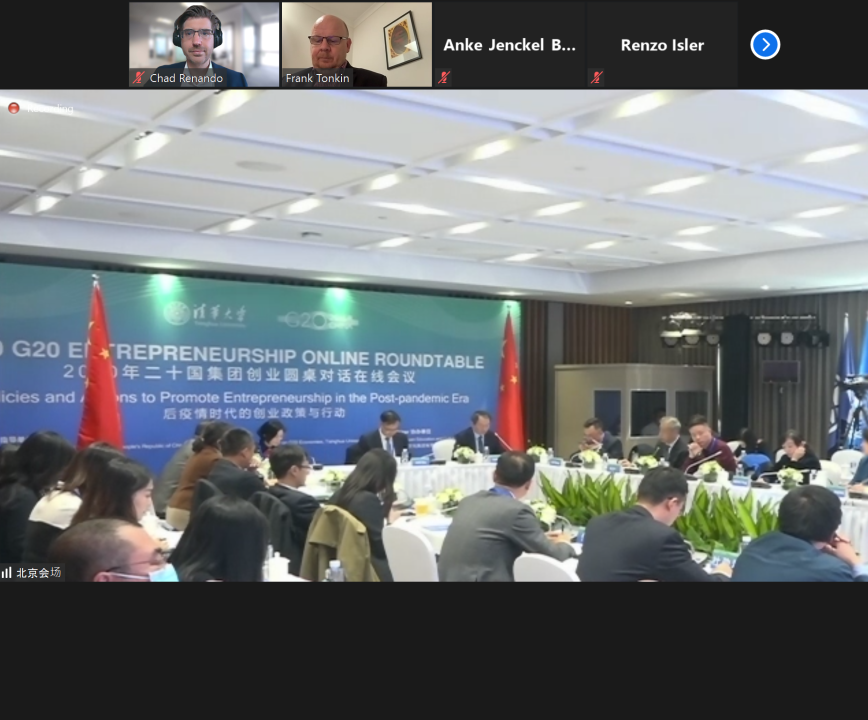I recently had the honour of sharing virtually at the 2020 G20 Roundtable on Entrepreneurship. The theme of the session was “Policies and actions to promote entrepreneurship in the post-pandemic era“, and my presentation was in a session to “Boost entrepreneurship to promote employment”. The presentations from countries around the world highlighted that each country experienced the pandemic differently while many of the challenges and responses were similar.
An overview of the presentation is outlined below. I also caught up with my colleague and friend Vibhour Pandey to hear his perspective on the presentation to reflect on:
- What is the state of entrepreneurship in Australia?
- How has support for entrepreneurship grown over time, and across what sectors and where across the nation?
- What are some of the impacts and policy changes from COVID-19 on the Australian economy?
- What does the future hold for Australian entrepreneurship?
Our recorded chat is posted below as well as an overview of each slide. This is just one perspective, and I welcome the views, feedback, and perspectives of others.
The G20 Roundtable on Entrepreneurship
The G20 Roundtable on Entrepreneurship came out of the 2016 G20 Labour Employment Ministers’ Meeting in Beijing, which resulted in the establishment of the Entrepreneurship Research Centre on G20 Economies and the acceptance of several documents including the G20 Entrepreneurship Action Plan. The G20 Roundtable on Entrepreneurship has been held for each year since with member countries reporting on the progress of entrepreneur support in their respective regions.
Entrepreneurship in a post-pandemic Era
The topic for 2020 was “Policies and Actions to Promote Entrepreneurship in the Post-pandemic Era”. Member countries shared about their respective policy measures framed broadly using various terms in three approaches: Sustain / Response, Transform / Recovery, and Transition. Approaches are often specific to each stage, such as job saving initiatives and increased support for unemployment in the initial Sustain and Response, retraining and investment in digital skilling for established businesses in Transform and Recovery, and investing in new industries and innovation tax incentives in Transition. The IMF has a good overview of policy measures by country.
Listening to responses by other countries, I was struck by both similarities and differences. Each country experienced COVID-19 differently based on factors such as population density, previous economic condition, socio-political landscape, and when the pandemic hit relative to the global spread. The mechanisms to address the pandemic were similar, including tax incentives and deferrals, job stimulus packages, sector-specific recovery plans, specialised grants, and rate cuts. The combination and intensity of these mechanisms varied, with some countries placing a greater explicit emphasis on innovation and entrepreneurship.
Representing Australia: Boost entrepreneurship to promote employment
So what would you say to best share about and represent Australia in an 8-minute presentation on the topic “Boost entrepreneurship to promote employment”?
I was conscious that delegates may have limited insights into Australia’s entrepreneur support system. I wanted to share some insights into the COVID-19 response without getting into too much detail. I was also keen to present Australia in a positive light, acknowledging there will be debates in most countries on appropriate measures and whether enough is being done to support new businesses.
The story I aimed to share is outlined below:
1. Set the scene
Australia is strong in corporate entrepreneurship and over one in ten Australians are involved in early-stage entrepreneurial activity of some form
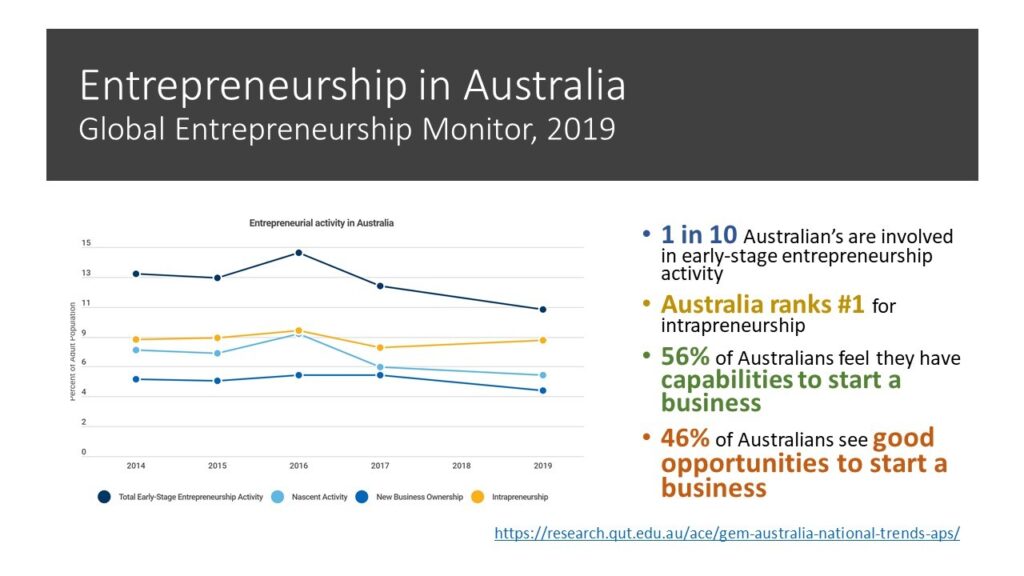
Based on a random, representative sample of 10,000 Australians, the 2019 Global Entrepreneurship Monitor identified that between 10.5% to 11.8% of Australians are involved in early-stage entrepreneurial activity. This includes intrapreneurship (entrepreneurs working in a business for an employer), new business ownership, and early or nascent activity. Australia ranks first out of the 50 participating countries for intrapreneurship. Over half of Australians feel they have the capability to start a business, while just under half see good opportunities to start a business where they live.
Australia’s entrepreneur potential is strong, but it is often held inside established institutions focused on local challenges. There are opportunities to further focus on external and global opportunities.
2. Australia’s ‘entrepreneur ecosystem’ has grown rapidly
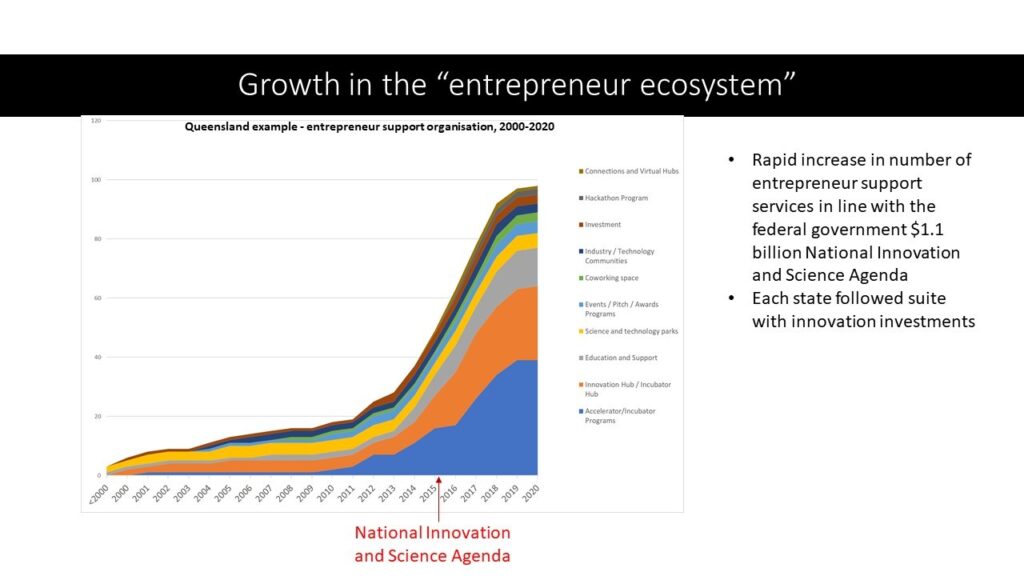
The federal $1.1 billion National Innovation and Science Agenda was released in 2015. Many states followed suit with their own innovation programs including Victoria’s LaunchVic, Queensland’s AdvanceQld, and New South Wales’ Jobs for NSW. There was also a rapid increase in incubators, investment groups, and innovation and entrepreneur-focused programs such as accelerators and hackathons. While there was already momentum from general trends in technology and global influence, the national and local policies had a significant contribution. This growth was levelling out by 2019 due to market rationalisation and geographic saturation. The diagram below shows the growth in Queensland as an example, and other states and territories have a similar trajectory.
3. There is a strong support network for Australian entrepreneurs and Australia’s innovation capability is diverse and integrated
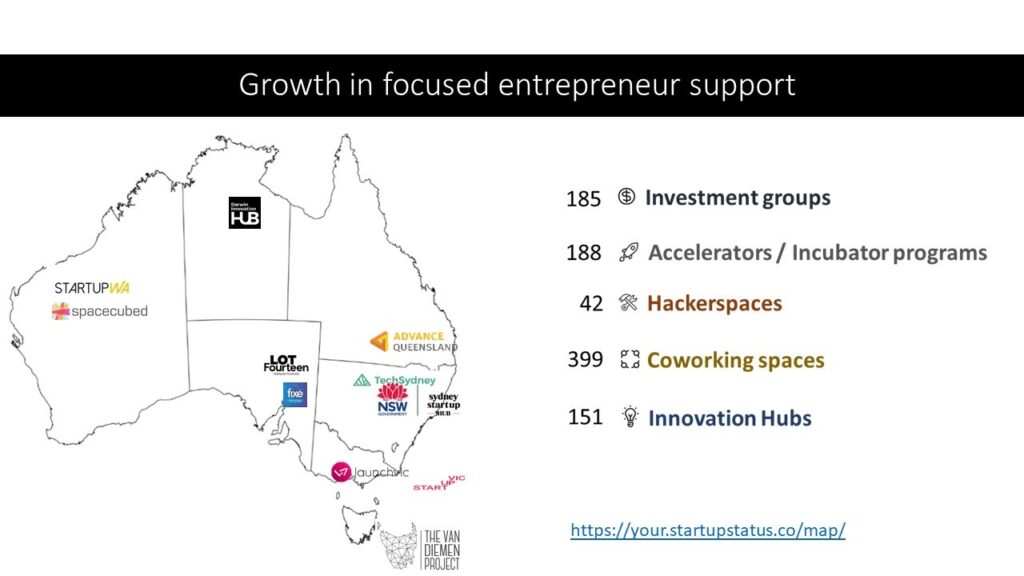
A number of investment groups, programs, and spaces have been established across Australia. Each state and territory has a dedicated program or space that is representative of the entrepreneurial community. We are also seeing focus areas in innovation and entrepreneurship emerge including aerospace and defence in Northern Territories and South Australia, resources in Western Australia, Agriculture in Queensland, and health in Victoria. Regions are specialising in specific sectors and technologies, while also building on existing strengths and diversifying.
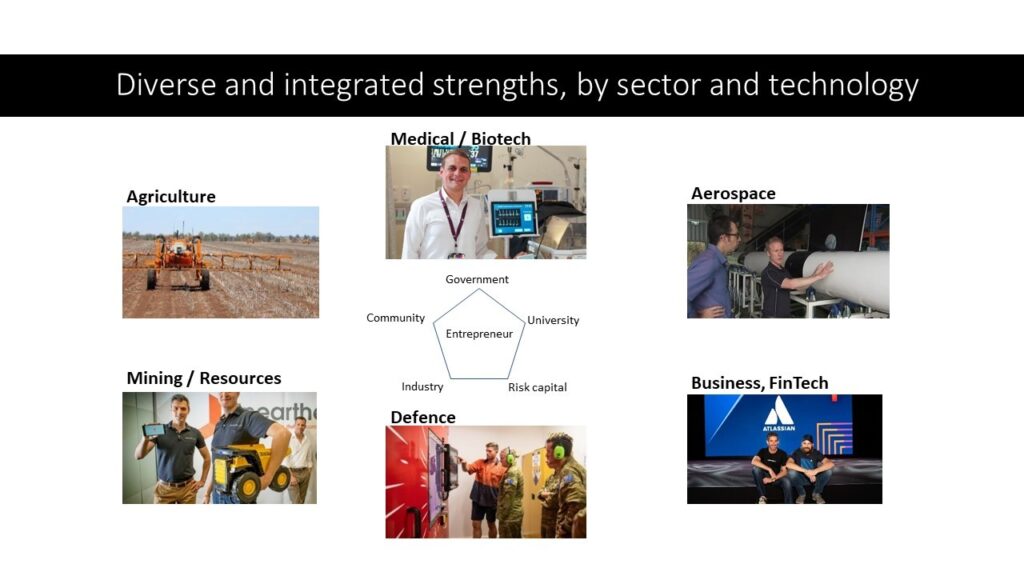
Innovation happens at the cross-section of different ideas: Agriculture, artificial intelligence, and aerospace; Defence, mining, and advanced manufacturing; Fintech and cybersecurity. This involves all aspects of the ecosystems – government, universities, risk capital, industry, and community – all focused on the entrepreneur’s success.
4. Risk capital investment is growing in Australia even through the pandemic
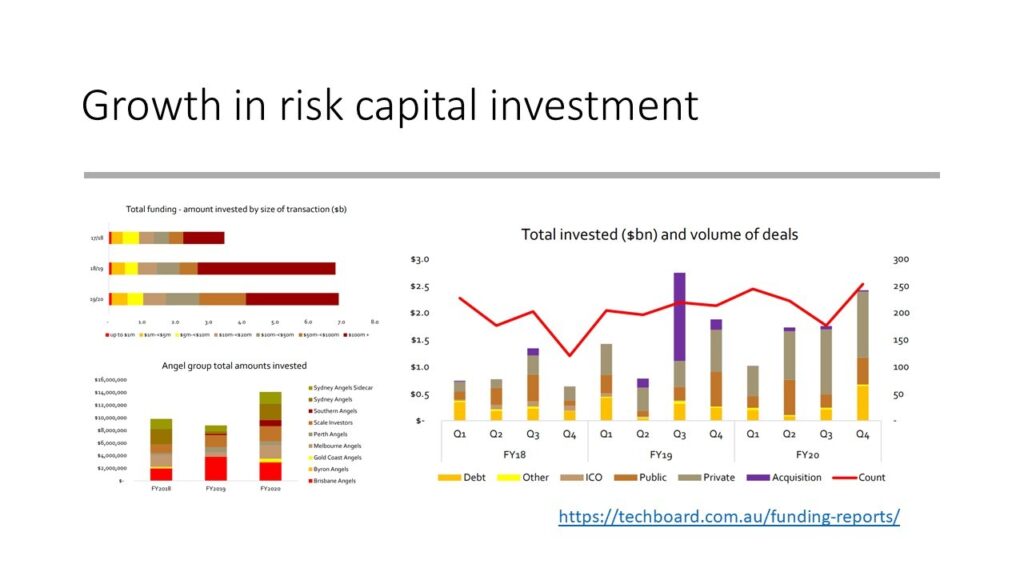
Activity of new support organisations and programs is only one indicator. We are also seeing sustained and resilient investment of risk capital. Based on funding reports from Techboard, we are seeing increases in the total number of investments, the amount of investment, and the diversity of investment sources event through the pandemic.
5. COVID-19 has had an impact
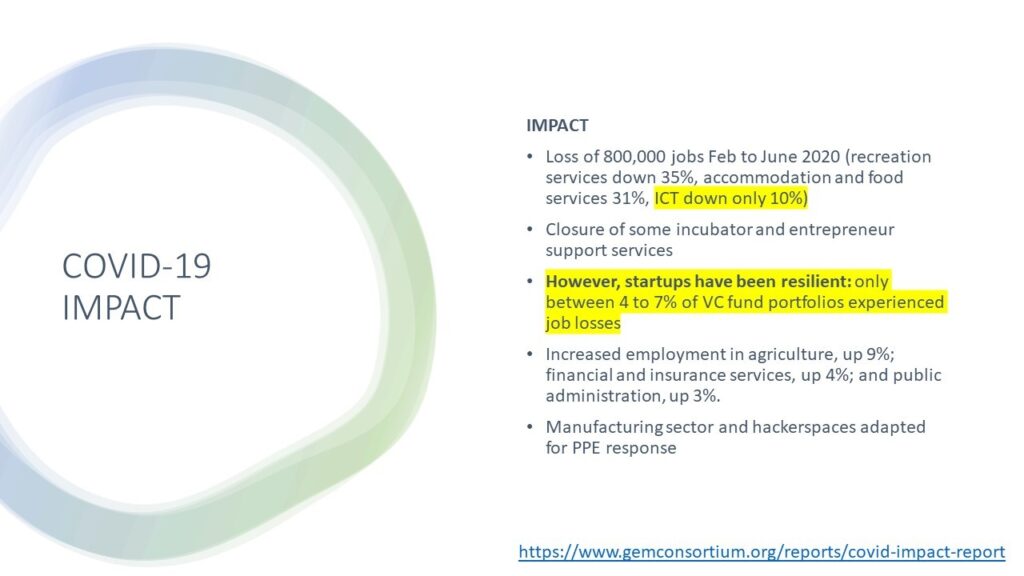
Australia lost 800,000 jobs between February and June 2020, with some industries down by over a third. We have also seen the closure of some incubators and entrepreneur support services. You can read more from our submission to the Global Entrepreneurship Monitor COVID-19 impact report along with other countries.
However, startups in many cases have been resilient, Asurvey of 15 VC funds reflecting only 4 to 7 per cent of respondents indicating job losses and the ICT industry overall down only 10 per cent. Other sectors such as agriculture and financial services increased through the pandemic and there were cases of manufacturing pivoting rapidly to support the pandemic efforts.
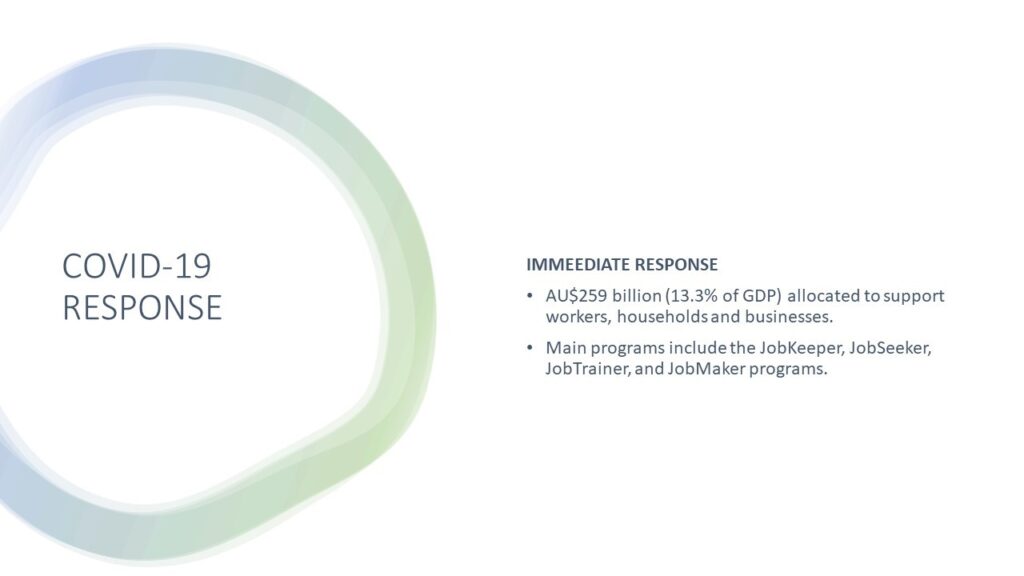
Australia invested $239 billion into the initial response efforts through a range of programs, over 13% of the GDP. The recent budget has specific initiatives suited to innovation and entrepreneurship, including continued support for the R&D tax incentive, investment to support businesses engaging in digital technologies, and investment into manufacturing strategies.
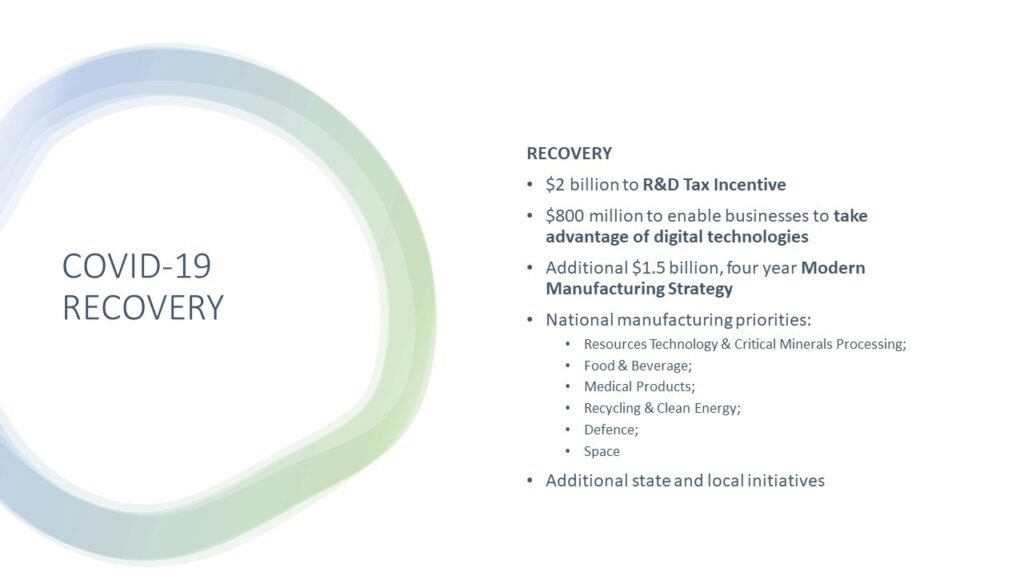
6. We have our work cut out for us
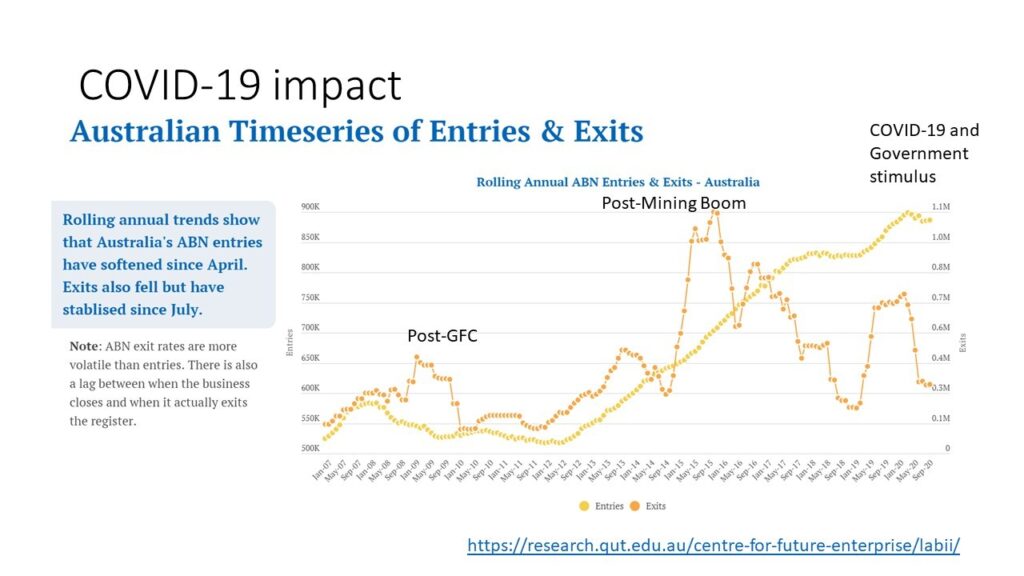
The rate of new business entries has increased steadily, but has been impacted by the pandemic. There is a good tracking in the report from the Longitudinal Australian Business Integrated Intelligence (LABii) report. The stimulus is decreasing the normal trend in business exits, and we can expect a spike once stimulus stops. But we have experienced challenges in the past and we can get through this.
7. The way out is through – new business activity is critical for our future
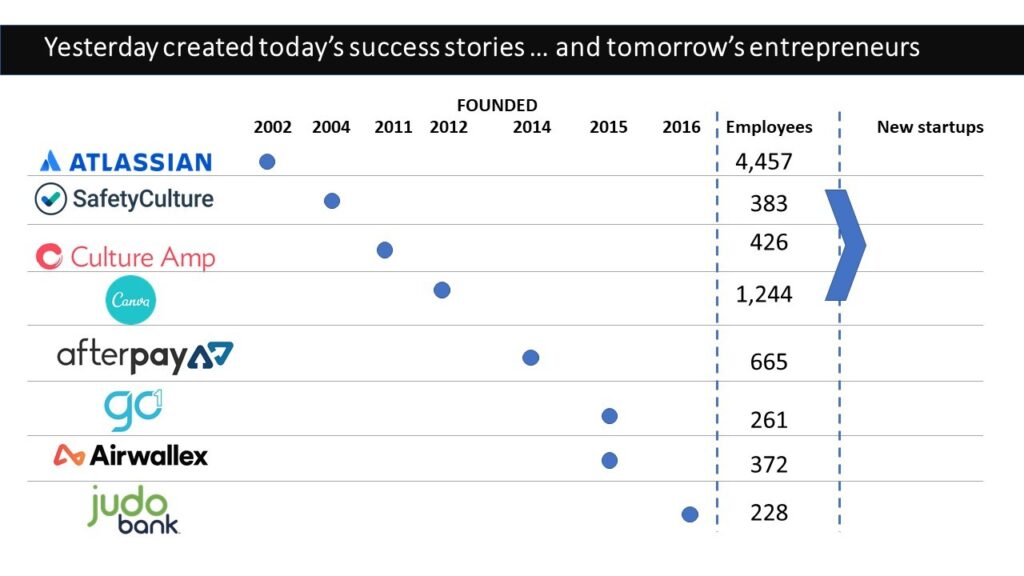
Any success story we read about today was in a garage, incubator, or hackathon yesterday. These companies are not just creating the jobs for today. The people who work at these companies are gaining valuable skills and experience. Research proves that these people will go on to form their own companies and startups, building on and advancing what they learned from their previous employers. Many of the startup founders of tomorrow are working in the Atlassians, Safety Cultures and Canvas of today.
8. Our opportunity is to learning from the pandemic and leverage the disruption for new growth
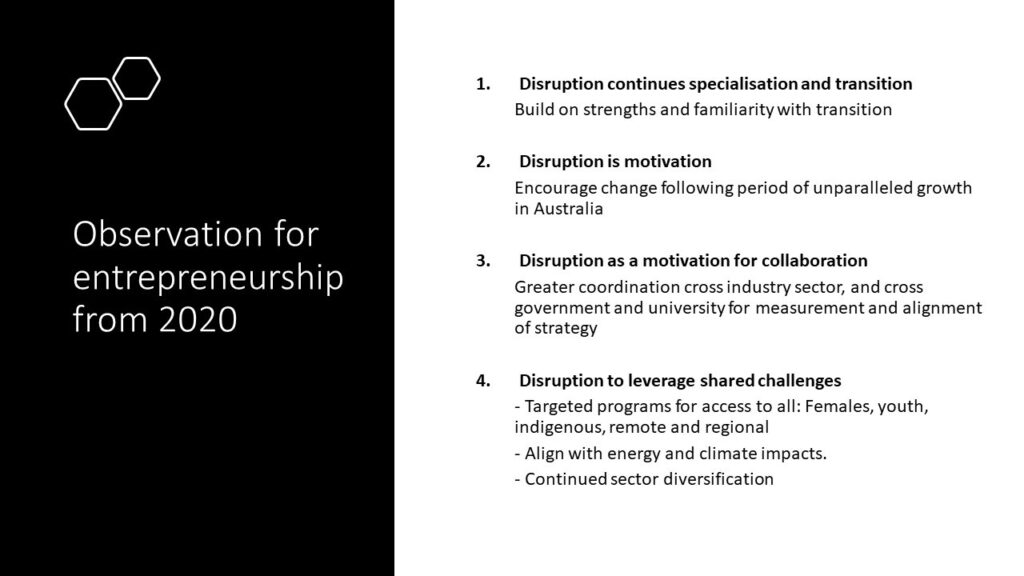
There are four broad observations we can make from the pandemic.
First, we can use the disruption to continue our focus transitioning economies. Australia is familiar with transition from dominant industries such as the resource sector and agriculture. Build on the narrative to transition to new technologies and innovation prompted by the pandemic.
Second, use the disruption as motivation. The previously mentioned GEM report also identified Australian’s have a relatively high fear of failure. The pandemic can shake us out of our comfort zone and prompt action in new directions.
Third, the pandemic has prompted new collaborations between industry sectors and roles in the ecosystem. Leverage these to enhance collaboration across industry sectors and roles such as governments, universities, and risk capital.
Finally, the pandemic is not an either/or situation with other major challenges. The pandemic exposes inequalities for those who may not have access to opportunities based on gender, geography, or nationality. Build on the momentum for change to address other challenges of climate impacts, regional locations, or demographics.
What’s next
Support for entrepreneurs in Australia has grown over the years. The ‘ecosystem’ has expanded regionally, is more focused by sector, and is increasingly dedicated towards diverse communities. In what is referred to as a complex adaptive system, the ecosystem is continuously evolving to meet the needs of the country.
Critical to success is increased collaboration between regions, across industry sectors, and through all levels of government, research, education, finance, and industry. The formula for entrepreneur ecosystem collaboration is simple in principle but difficult in execution: mobilise around a common challenge and focused on the success of the entrepreneur.
The ecosystem will continue to adapt to address the unique challenges introduced by 2020 to support growth of new forms of business into 2021. Having been a participant and contributor in the Australian ecosystem for the the past two decades, I am encouraged by where we are going and the strong foundation on which we can build.
Mine is just one perspective, informed by my roles as a Research Fellow with the Queensland University of Technology, Research Fellow (Innovation Ecosystems) with the University of Southern Queensland, CEO and founder of the not-for-profit Startup Status, and Managing Director – Australia for the Global Entrepreneurship Network. Your views and stories are welcome and appreciated as we work together to make a difference for those giving it a go.
